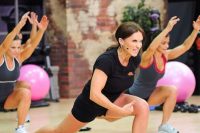Getting stronger and getting toned muscles is not just about developing strong muscles by lifting heavier weights, but also increasing neural pathways from your brain to your muscles. In fact, until you thoroughly develop neural pathways to a muscle it is very difficult to increase the size of that muscle or to even get the maximum benefit of your training effort. You’re only as strong as your weakest link and most people focus on what they do best, not what they need to work the most. This is where XTRAIN 100 Rep Challenges can help and why we have included them in this series.










